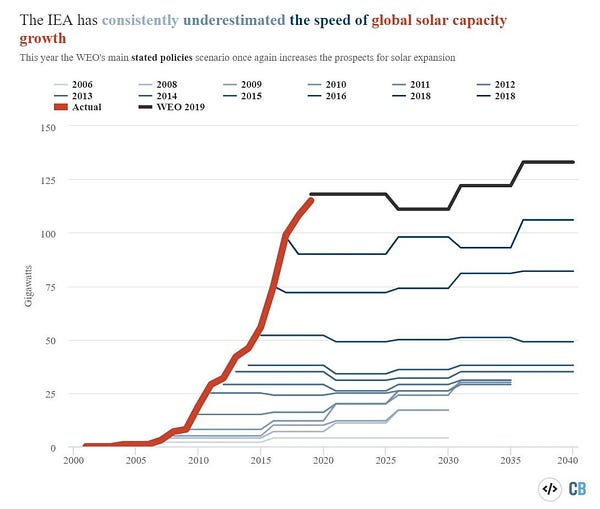How to Do R&D Right
In the wake of the Competition Act's Passage, what other changes does the R&D ecosystem need to flourish?
Last night Endless Frontier aka the U.S. Innovation and Competition Act passed the Senate by a 68-32 margin. As covered on previous ChinaTalk editions, a core piece of this bill authorization to pour billions into Amerca’s R&D establishment.
In the runup to the bill, over the past two weeks on the ChinaTalk Podcast I had on two PhDs who are working on fixing America’s research system in ways I think are much smarter than what Endless Frontier is advocating, which is essentially giving the NSF, DOE and National Labs ecosystem more money to continue doing more of the same thing.
First up is Ben Reinhardt, a robotics PhD formerly of Magic Leap who currently works as an independent researcher writing fantastic deep dives on DARPA and how their model is applicable more broadly. In the show, we talked about what makes DARPA so special, why American space funding has been so poorly spent over the past few decades, and how the R&D system needs to evolve.
“In order to get truly amazing things you actually have to be a bit irresponsible!”
Jordan: Why do corporate labs suck nowadays, save a few in software firms like Google’s Deepmind?
Ben: It comes down to a combination of changes in the dominant technologies and changes in the structure of businesses.
Corporate labs depend on monopoly-level profits to give them the sort of the leeway to what I recall piddle around to actually discover really good things.
In the late seventies, early eighties there was a combination of globalization and financial pressure from shareholders that amped up competition and made firms specialize. The technologies that corporate labs were working on in the 20th century became commoditized so your profit margins go down, so then you put more pressure on researchers to deliver, and that backfires and makes everything less efficient.
All like corporate labs that seem to like really be crushing it happened to be run by software companies who have near-monopoly profits, right? So you have Google and Facebook making big AI breakthroughs. These labs are aligned with the core products.
Jordan: Why can’t VCs deliver the hard tech breakthroughs we’re hoping for?
Ben: I think a common conception is like, academic research’s failings aren’t a big deal. Academia can stop at building out a proof of concept, because then you spin it out into a startup and you're off to the races.
But startups, especially like VC funded startups, are under a different set of constraints where in order for VCs to really make a return they need to believe that any single company that they invest in could return like a hundredfold or more on their money. This means that from day one VC backed companies need to have a plan for how they get huge. In engineering design, you need a lot of like experimentation, a lot of just piddling around when you won’t be constantly growing.
The necessity of the piddling around to actually do the engineering design that's not being done in academia and the need to grow really quickly are at odds.
Software has like really good economics because the capital cost is almost zero. If you can invest in something with zero capital costs or you can invest in something with non-zero capital costs, and they're both going to give you the same return you're going to invest in the thing with no capital cost. There obviously there are VCs that do invest in things that aren't software, but they're extremely specialized and there's only a sort of a small subset of hardware that they can reasonably go after.
Jordan: I like your line about how you can do big complex engineering products, but only so far as they look like something that had been done before, like a telescope or a particle accelerator, because then it’s legible tot he broader funding ecosystem. However, anything crazier than that, not just like a two X bigger, faster, better version of what already exists has a really hard time making it through the funding system.
Ben: Totally. And why isthat? My theory is that all science funding is explicitly or implicitly done by committee.
Committees are really good at is preventing downside risk. They do this by slicing off the tails of the distribution.
Jordan: Do you have any idea of where the Pareto frontier is for national R&D spending?
Ben: The dividing line between research, which is this explorative, unscheduling thing, and development, which is okay to we have deadlines and you have focused targets, is that you actually have to constantly pivot back and forth. For instance, say you’re doing development and then all of a sudden you encounter a problem you have to do research on. And then once you do that research you pivot back into development. It’s really more of a big cycle than just saying, okay, we’re going to give this pile of money for research, and this pile of money for development.
In terms of the Pareto frontier, I don’t think it’s a number, but rather what types of activities we are enabling. The one thing I’ll get on my soapbox to promote is that it’s much more important to enable different activities than to enable more of the same activities, namely academically incentivized work with is where the majority of federal dollars go towards.
Jordan: What do you think should not exist in the current US research ecosystem?
Ben: Oh, I'm going to make so many people hate me.
University administrations should be gone. I think a lot of the work that national labs do is really like a make work, and frankly, the whole thing needs to be scaled down.
I think it was Michael Nielsen who proposed the thought experiment of could we get better research if we just cut the money? There's this paper called the decline of unfettered research that makes the argument that the more money we put into research, the more people there are, and the more it becomes a commodity that we expect consistent results, but by expecting consistent results we kill the thing that is at the core of research, namely this like high variance discovery process.
If you know that you have to deliver something in three months, you're not going to work on the weird project. You're going to work on the thing that, you can deliver in three months.
Get rid of reporting requirements!
Whenever you get a federal grant, you have to tell them exactly what you're spending all the money for and every semester or every reporting period. You have to say exactly how much money you spent, exactly what you spent it for. If you don't or you screw that up or you spend it on the wrong thing, they take your money away.
Very often it's required that you spend most of the money on grad students, which probably gets a whole other problem. Why not decouple research funding from this idea of training America's research workforce, which is rhetoric you see all the time. What ends up happening is that all the money gets earmarked for grad students. That incentivizes people to do grad student-heavy research which makes it so that nobody will invest in building research tools.
Also it creates too many grad students. If you look at the number of grad students versus professor positions, the number of of grad students is increasing exponentially while the number of professor positions is basically holding constant.
All of these things I'm saying to cut, they exist for a reason, right? Like the reporting requirements exists because at the end of the day, it's taxpayer money. I don't want the government to be irresponsible with my money, but at the same time, in order to get truly amazing things, you actually do need to be irresponsible.
And next, excerpts from my interview with Ilan Gur. Ilan is the CEO of Activate.org, which funds the Activate Fellowship to give researchers two years of support to translate their lab breakthroughs into products and businesses. He previously worked at ARPA-E and Cyclotron Road.
What Can We Do With All This Funding?
Jordan: Ilan, what’s your hot take on the R&D spending in Endless Frontier?
Ilan: It's really not about how much money gets spent. It's about how we spend it. I'd argue that probably about $20 billion over five years, if spent in the right way, could really transform the US innovation enterprise. And when I say in the right way, I mean, find those aspects for R&D that are most missing in today's systems, the ones that are those bottlenecks, and let’s invest in those let's invest in experiments around how we do research better, how we manage research differently, and how we improve the incentives, to get the outcomes that we want.
You can run a lot of really substantive and significant experiments with $5 billion a year. So let's choose our battles. Even if 20% of the funding they're talking about here gets spent in the right way we can make something really powerful out of this and have a lot to celebrate.
Jordan: Ilan, one thing I want to get out of my tax dollars spent towards academic research is stuff like the MRN vaccine, which is currently coursing through my veins. It almost didn't happen, though. So what about our funding system gave the researchers who ended up giving humanity this breakthrough such a difficult time?
Ilan: Academic research environments are incredible environments to train and inspire talent. They drive exploration, novel ideas, and new discoveries. Academia today is actually quite connected to industry. But when you look at the core incentives of an academic researcher, the question of what should I do when I wake up today, the general bias is towards: "Let me go discover new knowledge, think about how it might be applied, but not really go too far down that rabbit hole, and instead make sure that I'm sharing the new discoveries and knowledge so that others out there can pick it up and run with it and apply it."
Where we sometimes have bottlenecks is the question of who will do the really hard work involved in figuring out how those early scientific discoveries actually translate into something valuable or implementable or viable in a field deployment or a commercial space. If you think about mRNA and COVID vaccines as a case study, one view is: "The system did its job. We funded an enormous amount of fundamental research and somewhat applied research, within academia that formed the bedrock of the ideas that allow things like an mRNA-based vaccine to exist."
I think the sort of pure economist might argue that was fine, that COVID-19 hit and the system did its work, and we got it done.
There's another frame that I think about, which is: we had invested a lot in the fundamental research around vaccines as a concept. The smartest folks in the fields of epidemiology knew that at some point there was going to be a massive pandemic that would wreak enormous havoc on society. So the question becomes,
"What prevented us from actually positioning towards the practical development of those vaccines before the pandemic hit?"
There you start getting into the role of government because there's a market failure here. Who's going to pay to develop a vaccine when there's not a pandemic that needs them as a solution? COVID-19 exposed the idea that when it comes to applied research, when it comes to developing a practical implementation of one of those scientific ideas, there are cases where taxpayers and the government should be investing in getting things closer to deployment because it's important to society and the private sector is not going to do it.
You've got case studies in Moderna and BioNTech. Both are essentially examples of researchers who lived within academia and said, "I really want to focus on the applied aspects of this," which left them feeling like misfits within the academic culture and incentive structure. Luckily for our society, they decided to go do something that their friends and relatives probably thought was totally nuts, which was leave the safety of academia to start a company that doesn't really have a product and was basically a little shop that did applied research. Thankfully, those brave folks were doing that applied research for a number of years and it's one of the reasons we were positioned to have the rapid solutions to COVID 19 that we did.
Jordan: I'm curious, Ilan, where should the marginal taxpayer dollar be going if you're looking to try to unlock the next mRNA vaccine? Is it a sort of absolute question (amount of dollars), or is it more about the way this money is spent?
Ilan: I think we'd all agree that scientific discoveries can be the basis of enormous value. How do we capture that value? Whether you come at it from a social good perspective or a competion perspective, what's the goal?
I think we're all interested in seeing the non-linear opportunities in government spending? Is there a chance that the marginal dollar doesn't just get you just a marginal percentage increase somewhere but instead unlocks something really big and different? Let's find those bottlenecks and use this money to open those floodgates where we can.
I think there is an enormous opportunity for the U.S. at the intersection of science and entrepreneurship. Startups still in the research phase—pre-commercial startups—are like very powerful, robust, custom-built vehicles and shuttles to move research ideas forward.
I'd love to imagine that government money, whether it's connected to the incredible pieces of the research infrastructure we have in academia or elsewhere, ends up unlocking startups as both a really powerful impact vehicle and a competitive strength.
You can also think about things like workforce development. We know there's a bottleneck there. Not just in how we're training folks for non-academic career paths but also in that we have a very narrow and elite sort of pipeline of talent.
When you look geographically, racially, gender-wise across the country, the people afforded the opportunity to get into science and technology, and certainly to get into applied research at the highest levels, there's a bottleneck. Let's figure out how to open those floodgates.
Every new dollar we spend should be addressing a bottleneck, opening a floodgate, that otherwise might not be happening and should give us some non-linear impacts to how all the fundamental research that we've been investing in actually impacts your average American—for example, translating things like vaccines for pandemics that don't exist yet because if we're more prepared, the average American is going to benefit.
Or look at infrastructure, right? We know that the really strong innovation mechanisms we have today, like venture capital, do a really poor job driving infrastructure innovation. There's a regulatory bottleneck because there's a much higher risk factor associated with the timeline and resources needed to prove out a new infrastructure technology because market adoption is so much lower. But we also know that we need more, better infrastructure in this country to be resilient to climate change and, simply, to serve society better.
Jordan: So what do you think about the government taking stakes? This is something that a lot of other countries have a lot more comfort in doing than the U.S. I'm curious if your sense of having more direct investment on the U.S. government side is something that's useful or beside the point?
Ilan: I will say it can get really messy to transition from something that's oriented towards social good to something that's commercial. As soon as you get to that interface, things get tricky because the cultures are different, the incentives are different. So even if it makes sense, theoretically, I tend to find that practically there's a bunch of mess that comes when those two are entangled. How do you design these systems while being really thoughtful about how you approach that interface?
I personally don't like the idea of the government taking equity or otherwise in the research because if there's anything I've learned, it's that when it comes to market and pure economics, governments tend to be non-rational actors. The government should be a non-rational actor.
So all of a sudden, you can get all these weird perversions of what would naturally happen in the marketplace when you have a government as a stakeholder in those market conversations, and this comes up in a number of different ways.
So I am a much bigger fan of figuring out how the government can appropriately unlock the impact that it wants to see. I think about it from two dimensions: (1) as we talked about, how do you do the bottoms up? How do you support the talent and infrastructure to do commercially motivated research that maybe has an applied motivation, but where it's clear that it's not a product or a business yet. (2) I think the other thing, and this is something I hope we start seeing, is how can we do a better job incentivizing the corporate world and the private sector to be more risk-taking and speculative and ambitious when it comes to scientific innovation in a way where the government's not messing with the market?
One of the things I would love to see, especially in the U.S. we're trying to think about how we drive domestic manufacturing and employment, is a program where the government incentivizes U.S.-based corporations to acquire and integrate technology from U.S. startups. How do you get the government to say, "we want these things to stay in the U.S., and we know we want it to benefit our economy, so let's get our hands into it"? Let's take the organizations that can deploy the technology at scale and incentivize them. Corporations are already looking to engage with startups. The problem is they normally can't be as risk-taking as they might want to be. Let's give them a reason to put more money into these new ideas.
Tweets of the Week







Not China-related but the majesty of Twitter really on display in this thread above…within 15 minutes I got some really informed feedback on a super obscure founding father and reconnected with an old college professor!




















